I have a staircase to the basement with a 90 degree turn. I can take away the door and railing on the stair to make things easier. From what I have seen it appears the best thing to do is use a skid of wood underneath. I know I can remove some parts to lighten up the lathe. But advice on this would be appreciated. Should I just tie a strap to the skid and lower it down by hand. I will have a few strong younger guys to help. what about turning 90 degrees? See photos of my basement stairs both going down and coming up. Ill remove the cat litter of course! Your advice is appreciated.





-
Welcome back Guest! Did you know you can mentor other members here at H-M? If not, please check out our Relaunch of Hobby Machinist Mentoring Program!
You are using an out of date browser. It may not display this or other websites correctly.
You should upgrade or use an alternative browser.
You should upgrade or use an alternative browser.
Looking to move a PM1130V into my basement
- Thread starter jimbo7636
- Start date
- Joined
- Oct 31, 2016
- Messages
- 2,649
Welcome to the forum.
I would take everything off of the lathe that you can. And I mean everything. When I have had to move my craftsman 12x36 I took everything off except for the headstock. By doing that I was able to move the lathe by myself. A friend of my has a dolly with 3 wheels that will walk down a set of stairs. Search for stair climber dolly. You find lots to chose from.
I would take everything off of the lathe that you can. And I mean everything. When I have had to move my craftsman 12x36 I took everything off except for the headstock. By doing that I was able to move the lathe by myself. A friend of my has a dolly with 3 wheels that will walk down a set of stairs. Search for stair climber dolly. You find lots to chose from.
- Joined
- Jan 2, 2019
- Messages
- 6,587
Hi,I have a staircase to the basement with a 90 degree turn. I can take away the door and railing on the stair to make things easier. From what I have seen it appears the best thing to do is use a skid of wood underneath. I know I can remove some parts to lighten up the lathe. But advice on this would be appreciated. Should I just tie a strap to the skid and lower it down by hand. I will have a few strong younger guys to help. what about turning 90 degrees? See photos of my basement stairs both going down and coming up. Ill remove the cat litter of course! Your advice is appreciated.
View attachment 440960
View attachment 440961
View attachment 440963
View attachment 440964
View attachment 440965
Is this the first tool to move into your basement? Do you own the house?
If so, you might consider what it would take to install Bilco doors because before too long you'll be wanting a mill, surface grinder, big granite inspection plate, etc.
I know not possible on every house but just something to think about....
John
- Joined
- Dec 15, 2022
- Messages
- 65
If you use the bottom pallet/skid that the lathe comes on, be sure and check the mounting hardware. Mine came with only 2 bolts attached (out of a total of 6 mounting points), and one of the bolt no longer had a nut installed... the other was finger tight at best.
As others have said, try to disassemble as much as possible... I still don't think it's going to be a very fun time fighting it down those stairs. I had mine on my tractor and going thru the front door of the shop and it barely fit (standard size door opening).
As others have said, try to disassemble as much as possible... I still don't think it's going to be a very fun time fighting it down those stairs. I had mine on my tractor and going thru the front door of the shop and it barely fit (standard size door opening).
The 90 degree turn in the stairs is a problem. Stair climbing devices make moving heavy objects up or down stairs doable. We had a patient of over 350 pounds to remove up a flight of stairs from a dock where we used one. Made an impossible job workable with out any hurt firemen.
first tool move. I asked about the PM-728VT mill as well. They told me I could dissassemble that into pieces and basically carry it down into the basement. The lathe however, they said to take off most stuff and use a wooden skid at PM. I like the Bilco door Idea and I wonder if I could get that done for under $5K. I do own the home so putting it in would be possibleHi,
Is this the first tool to move into your basement? Do you own the house?
If so, you might consider what it would take to install Bilco doors because before too long you'll be wanting a mill, surface grinder, big granite inspection plate, etc.
I know not possible on every house but just something to think about....
John
- Joined
- Dec 18, 2019
- Messages
- 6,538
I made a sled for my lathe, then some guided ramps, and finally an elevated platform at the bottom of the stairs. The lathe was guided down the stairs using a come-along until it got to the platform. Then it was swung around and lifted onto the lathe stand, which was the same height as the platform. The lathe stand had wheels, so it was then wheeled into place. It was a ton of work for only two people, but we got it done. At no time during the lowering was anyone on the down slope of the lathe. Made it harder, but it was safer for the both of us. And no, that platform wasn't big enough, but it had to do. As you can see, that is a narrow stairwell. Learned a lot in this move. For my mill, I took it apart and got some (hired) help carrying it down.
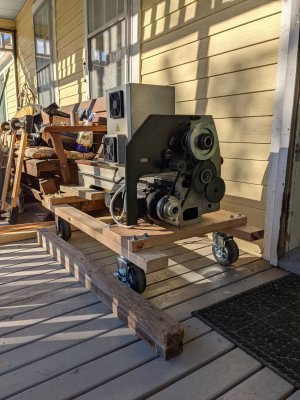
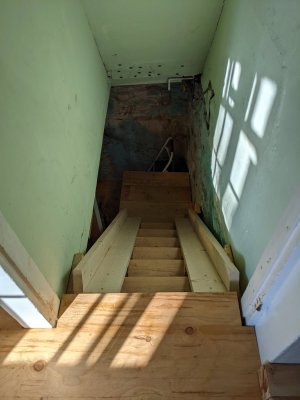
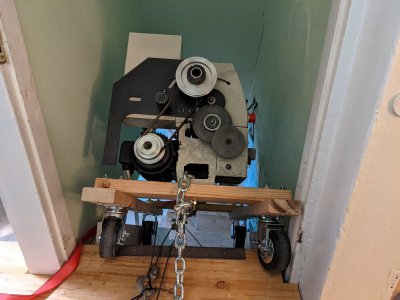
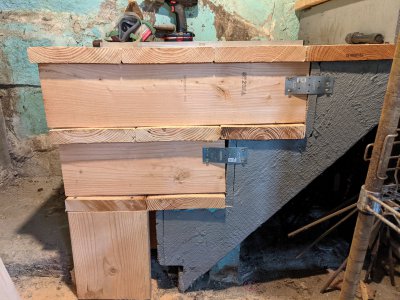
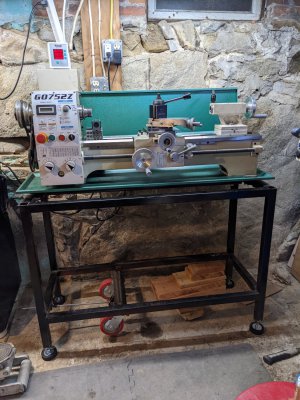





I had to take my lathe (290 kg) complete apart (1 day job, bagging and photographing) to get it upstairs on my own. The assembly took a week. Because it was a new Chinese lathe, I took the opportunity to do the maintenance and scraped the saddle guides a little to get all four courners flat on the bed. Now it runs for more than 3 years and I am happy with it.

